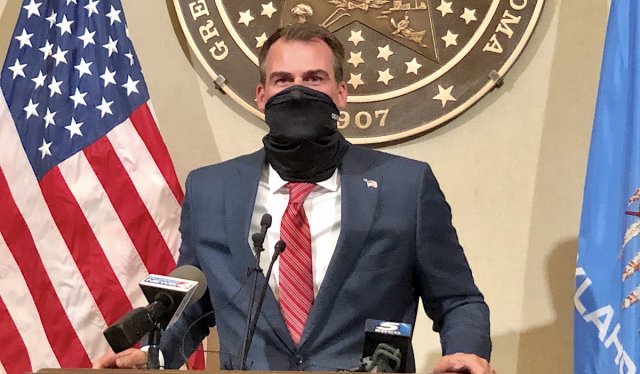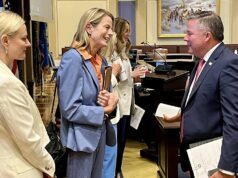
Oklahoma Gov. Kevin Stitt has emphasized the optional nature of mask wearing for weeks’ worth of press conferences, but today in a briefing before the Fourth of July weekend, the Republican governor urged the state’s population to wear masks when social distancing is not possible.
“Research shows that wearing a mask when you can’t social distance significantly lowers the risk of transmission rate of COVID-19,” Stitt said. “It may take some getting used to, but it’s a small price to pay to be able to keep our businesses open, our economy running and to be able to watch OU and OSU stick it to the Short Horns on the football field this fall.”
Stitt then hiked a black mask — emblazoned with Oklahoma’s new logo — up from around his neck and over his mouth and nose.
“So it’s this easy,” Stitt said.
The first-term governor’s demonstration of masking-up came on another day of Oklahoma’s COVID-19 positive cases going up, this time by 585, a single-day reporting record.
“We need to protect our fellow citizens,” Stitt said. “We don’t want to see spikes.”
Asked what has changed since his recent public events and press conferences where he did not wear or fully endorse mask wearing, Stitt reiterated that CDC guidelines have only recommended masks be worn in situations where social distancing is not possible. (Those guidelines were updated to broaden the recommendation Sunday.)
“As governor, I don’t want to get to a point where we start shaming people for choosing not to wear a mask. There may be reasons why they don’t want to wear masks or can’t wear a mask,” Stitt said.
Asked if he will consider a mask mandate like other states have implemented, he was more direct.
“No, I will not reconsider mandating masks. We believe in freedoms,” he said. “We’ve been very clear that we are not going to mandate masks throughout the state of Oklahoma. When you start mandating things, the very next question is, ‘How are you going to enforce it?’”

Commissioner: ‘Heightened interest’ in testing
Stitt was joined at Tuesday’s press conference by Commissioner of Health Lance Frye, a colonel in the Oklahoma Air National Guard and an OB/GYN physician.
“We have seen record interest in our testing pods across the state,” Frye said. “Heightened interest of getting tested is a very good sign.”
Frye offered Oklahomans guidance ahead of the holiday weekend.
“As we celebrate our nation’s freedoms, we ask you to please wear a mask, wash your hands (…), use hand sanitizer and celebrate outdoors,” Frye said.
New Secretary of Science and Innovation Elizabeth Pollard also spoke about COVID-19 one day after being promoted into Stitt’s cabinet. She said testing capacity remains good but that the state continues to look for partnership opportunities.
“We want to do it in a way that is most effective,” Pollard said.
New color-coded COVID-19 alerts on the way
Stitt also announced that he will be releasing a new executive order to implement a color-coded COVID-19 threat alert system for all 77 counties.
“That will show Oklahomans the data on a county-by-county basis and give them the freedom to make the decisions they need to protect themselves and their families,” Stitt said. “We’ve seen localized outbreaks at different parts of the state. (…) We may be dealing with this virus for the next 24 months. This system will help Oklahomans deal with this.”
Last week, House Minority Leader Emily Virgin (D-Norman) and other House Democrats called for the implementation of such a system.
“Too many decisions during this pandemic have been made based on what is best for politics,” Leader Virgin said. “This system would help the process become a bit more transparent and more easily understood by relying on specific data thresholds instead of cherry-picked data that promotes one side’s political talking points.”





















